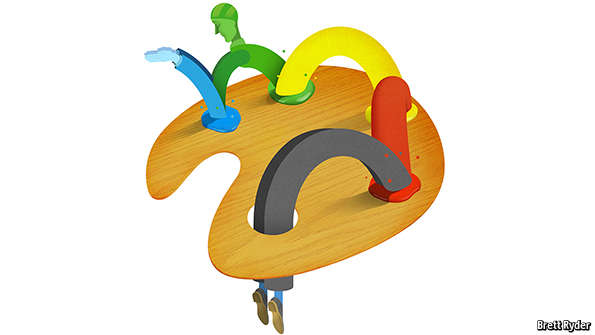Choosing a strategy is a lot more complex for companies than it used to be

BUSINESSES are bombarded with advice on strategy. Many gurus urge them to discover a “blue ocean” where they can swim without competition. Others argue that this is a pipe dream—a blue ocean will immediately be turned red by competitors—and advise them to focus on flexibility. Some pundits preach the first-mover advantage; others urge firms to be fast followers. Bosses end up confused and cynical, with some lurching from one strategy to another and others concluding that they never want to hear the word “strategy” again.
The Boston Consulting Group (BCG) made its name with clever ideas about strategy, most notably the growth-share matrix, which helps firms divide their lines of business into stars, cash-cows, dogs and question-marks. Now it has brought some clarity to the current confusion with a new book, “Your Strategy Needs a Strategy”, by Martin Reeves, Knut Haanaes and Janmejaya Sinha. The BCG trio argue that business is so fast-moving and diverse these days that a single, overarching strategy will no longer do. The competitive landscape is constantly changing in many industries; businesses speed through the life-cycle from stars to dogs. So, they say, wise bosses should choose from a “strategic palette” in much the same way that artists choose from a palette of colours. The book identifies a handful of primary strategies, that bosses should be ready to switch between and, at times, blend.
It starts with the “classical” strategy that business schools have taught since the 1950s: find a good niche, develop a plan to dominate it, then muscle up. Mars, a confectionery giant, maintains its dominance through close relationships with suppliers, relentless cost control and timeless products. The Milky Way bar was invented in 1923 and the Mars Bar in 1932. Consumer-goods makers such as Procter & Gamble, retailers such as Walmart and logistics firms such as UPS all use variations of this strategy. But stable markets are getting harder to find. So companies are making more use of four other types of strategy.
One is the adaptive, evolutionary approach. This is particularly popular among technology firms. Tata Consultancy Services talks about its 4E model—explore, enable, evangelise and exploit—which in English means trying lots of small things and then backing whichever ones work. But it can also be applied in older industries. Inditex’s global success as a fashion retailer is based on first producing its clothes in small batches, then scaling up production rapidly if they sell well.
Another is the visionary, blue-ocean approach: generate a compelling new idea—a whole new market, with you at its centre. This was Steve Jobs’s approach with Apple’s iPhone and iPad, but there are plenty of smaller examples. Anna Wojcicki, a founder of 23andMe, came up with a new health product—a kit that allows you to analyse your susceptibility to various diseases—and then focused on selling her new idea to both investors and the general public. “The average individual just didn’t know why they should get their genome,” she said. “So educating the individual and getting them excited about it was our first challenge.”
A third is the shaping approach: working with partners to create new markets. The partners could be private-sector ones. Apple and Google have worked with many small app developers to create an ecosystem of mobile services. Or they could be public-sector ones. Novo Nordisk, a Danish drugmaker, has captured 60% of the Chinese market for insulin by working closely with Chinese doctors and health authorities to raise awareness of diabetes, which had previously been under-diagnosed.
A fourth strategy—for companies on the brink—is renewal: refocus the business decisively, preserve capital, free resources to apply to areas of growth. After its government bail-out, AIG, a giant insurance conglomerate, got out of many businesses and took drastic action to stop rivalry and overlap between the rest.
Overlying all these options is the strategy of being “ambidextrous”, that is, being able to skip nimbly from one strategy to another, or to pursue several of them simultaneously. Some companies, such as PepsiCo, have two separate groups of people in each division: one whose strategy is to maximise the efficiency of the business in its current form, and another that looks for ways to disrupt it (before someone else does).
Smudging the canvas
The BCG trio’s taxonomy of strategies at least brings a bit of clarity to some of management theory’s cloudier waters. But they have little to say on how managers should apply their palette of strategies to the canvas without making a Jackson Pollock of it. The classical, niche-domination strategy often entails minimising variation to squeeze out costs; the adaptive strategy involves maximising variation so as to find out which variant works best. The shaping strategy is all about sharing between companies and others; the classical strategy is typically all about being closed and defensive. How to solve such contradictions?
Besides offering little advice on how best to pivot from one strategy to another, the authors also avoid discussing how companies can pursue a multi-strategy approach without creating battle lines between their various chiefs. It is simply assumed that the executives running the “business as usual” strategy will get along happily with those pursuing the “disrupt everything” approach. It is hard enough for businesses to switch wholesale to a new strategy without encountering resistance from managers who have tied their reputations to the old one; maintaining different teams working simultaneously on opposing strategies is a recipe for internecine warfare, and for wasting resources as the firm is pulled in opposing directions. The BCG trio are no doubt right that companies will need to become more ambidextrous if they are to survive in turbulent times. But what bosses need now is a book on how to prevent such organisations from becoming self-contradictory and conflict-ridden ones.



